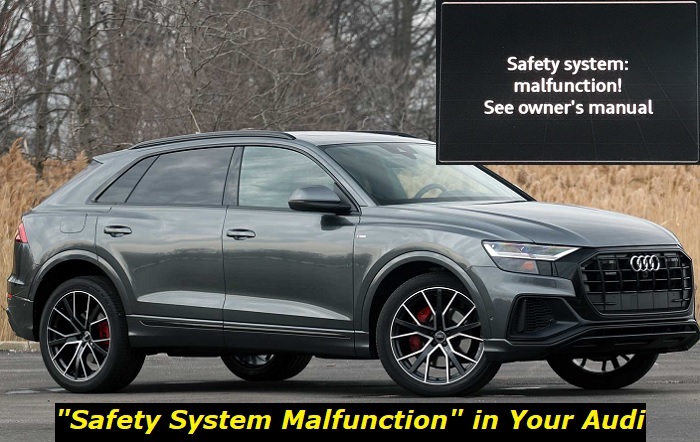German cars are among the best vehicles money can buy. This is majorly attributed to the high level of technology and comfort they provide, not to mention a boost in the owner's prestige. Audi is a car brand forming one in the line-up of German car brands. Your Audi's top-of-the-line safety system is designed to ensure inbuilt automated systems prevent you from getting into accidents.
Safety system error message highlights
- Common reasons:software problems, sensors glitching, issues covered by several recalls
- How to fix:go to the dealer - you won't do anything on your own
- Possible consequences:airbags not deploying, issues with other safety equipment
- Priority level:High
- Can you drive?Carefully
- DIY repair:Impossible
- Repair price range:$0-$500

Is the car drivable when it shows a "safety system malfunction" warning prompt?
The short of it is, yes. Your car is still drivable to the nearest service center. This warning prompt does not interfere with the functioning of the car. It only serves as an alert of something deeper at play. It is seen in the gauge cluster, or what is referred to as the dashboard.
It appears exactly as we quote here: "Safety system malfunction; see owner's manual." You should, however, apply caution when driving it to the center.
How Your Audi's Safety System Works
The safety system in your Audi is comprised of active and passive systems.
Active Safety Systems
Active safety systems are responsible for avoiding accidents in the first place, so they generally work to keep the vehicle firmly under your control - they are always "active." Some of the active systems include;
- Vehicle Stability Assist/Traction Control/ Electronic Stability Control
The traction control system works with the anti-lock braking system to prevent Audi from losing balance when accelerating. If the wheels start to lose traction, the engine power is automatically reduced to match the amount of grip available.
- Anti-Lock Braking System
During braking, wheel speed sensors monitor the rotation of the wheels. When one or more tires try to cease rotation, a system composed of hydraulic valves takes over the wheel's braking to prevent the vehicle from skidding.
- Electronic Brake Force Distribution
Electronic Brake Force Distribution, or EBD, is a subsystem of the vehicle's anti-lock braking system and traction control. The EBD system uses the vehicle's traction control and ABS to determine the ideal brake force distribution to all four wheels in a braking event.
- Brake Assist
Brake assist automatically brakes the vehicle in the event of an accident, reducing the danger of skidding and the risk of further collisions. The function uses the relevant sensors to detect a collision; the severity of the crash and the speed reduction are calculated by the safety computer.
- Tire Pressure Monitoring System
Many models from Audi are equipped with a tire pressure monitoring system integrated into the electronic stabilization program (ESP). It alerts the driver in the event of pressure loss by displaying a warning on the onboard monitor.
Passive Safety Systems
Passive safety systems are not actually doing any specific job. They rather make your car safer and they are not always only made for safety. A lot of these features are made for comfort and they only act as additional safety features.
Some of the passive systems include:
- Audi adaptive cruise control with Stop&Go and Traffic jam assist
Your Audi's cruise control adapts responsively to improve efficiency and adjust speed in heavy and light traffic. The advanced traffic assist system uses a front camera, sensors and radar to brake and accelerate automatically. This system ensures that driving in traffic is less bothersome than usual.
- Vehicle exit assist
The Audi vehicle exit assist is mostly available on pricier models. The system uses your car's LED lights to warn you whenever vehicles, bicycles or pedestrians are too close. It also prevents your door from colliding with other vehicles as you exit or enter.
- Turn assist & Collision avoidance assist
Your Audi's turn assist and collision avoidance systems rely on radar and camera data to monitor oncoming traffic. The system senses when you are preparing to turn and is on standby to apply emergency brakes if it detects an imminent collision.
- Night vision assistant
Driving at night adds the risk factor of poor visibility. The night vision assistant aims to compensate and allow you to detect and hazards ahead. This automated system warns you when you come within 100m of a potential hazard.
- Airbag System
This is designed to cushion the driver and the passengers from impact in a collision. It is deployed immediately after an accident and inflates quickly to reduce the injuries sustained by any occupant in the vehicle.
Causes of the safety system malfunction
1) Internal adjustments
This happens mostly when there you adjust your car's driver's seat. In most cars, the electronic control module; which is the car's computer; is located beneath the driver's seat. When you try to adjust the seating position, at times, this can disrupt your car's ECM. This will lead to the display of the warning light.
2) Airbag issues
When you see the warning light and message prompt in the digital cluster, there's usually an accompanying airbag symbol. This is indicative of problems affecting the airbag. This can be seen in your car if it has been involved in a road traffic accident. You can also notice it if your car's airbag sensor detects a technical fault within the airbag.
3) Braking system malfunction
Say, for instance, your car has damaged brake rotors. This can be brought about by driving for too long on worn-out braking pads. as the brake pad wears down, the metal becomes exposed, causing metal-on-metal contact when you apply the brakes to stop.
This contact causes deep grooves on the rotor, which eventually leads to damage to the brake rotor system. Now, when this happens to your car, the warning light will come forth.
4) Traction control system damage
Your car's traction control system develops problems with the wheel speed sensors, which, when exposed to elements, leaves them vulnerable. The magnetic operation on the traction control sensors can be interrupted by dirt or other buildups.
5) Anti-lock braking systems damage
Just like the traction control system, the anti-lock system in your car is vulnerable to elements. Anti-lock braking functions via an intricate system of sensors easily damaged by elements such as water, dust or any other buildup.
6) Major road accidents
At the risk of sounding redundant, if your car is involved in a major road traffic accident, it damages most, if not all, of these systems we discussed earlier on. This can lead to a persistence of the warning light despite complete repair of the vehicle's systems.
The sensors that bring about that warning prompt are difficult to repair and return to the normal state, where they do not show unless there's an issue. This leads to the constant display of the warning light and message prompt.
So, what is the solution in case this happens?
1) Running a diagnostic test on the car.
Whenever the message prompt is displayed, you should take your car to a certified dealer who can run a diagnostics test on the car's electronic control module. This helps log in to the car's computer and identify with pinpoint accuracy what the issue is. This also rules out the unnecessary display of the warning light when internal seat adjustments are made in your car.
2) Proper garage selection.
If you've had a major accident, you should be keen to ensure that the garage you entrust with the repair of your car is certified. This goes a long way in ensuring that proper sensors are restored to the car during its repair.
If faulty or fake sensors are installed, the warning light will always be on display. This also involves the prowess of the technician attending to your car. Hence, a good garage or service center is essential in solving this issue.
Preventing the safety system malfunction
There are a few ways of preventing a system malfunction in your Audi. This includes:
- Regular, thorough servicing and check-ups of the car.
When you take your Audi for servicing, ensure all the components that make due for the smooth running of the car are checked. If there are faulty brake pads, they should be replaced with brand-new ones.
- Careful driving.
It goes without saying that if you take care of your Audi, this will be a non-issue. Most of what we have discussed pertains to damage sustained on your car. If that can be avoided, then, in turn, the safety system will remain intact.
- Pay Attention to Warning Lights.
You should be keen and quick to take the car for a diagnostics test whenever you see a warning light on your gauge cluster screen. Or at least avail to a technician who will determine whether it needs one. Ignoring the warning can be detrimental to the car's overall performance if there's an issue in need of attendance.
About the authors
The CarAraC research team is composed of seasoned auto mechanics and automotive industry professionals, including individuals with advanced degrees and certifications in their field. Our team members boast prestigious credentials, reflecting their extensive knowledge and skills. These qualifications include: IMI: Institute of the Motor Industry, ASE-Certified Master Automobile Technicians; Coventry University, Graduate of MA in Automotive Journalism; Politecnico di Torino, Italy, MS Automotive Engineering; Ss. Cyril and Methodius University in Skopje, Mechanical University in Skopje; TOC Automotive College; DHA Suffa University, Department of Mechanical Engineering






Add comment